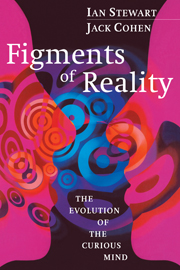Book contents
- Frontmatter
- Contents
- Preface
- Figure Acknowledgements
- Prologue
- 1 The Origins of Life
- 2 The Reductionist Nightmare
- 3 Ant Country
- 4 Winning Ways
- 5 Universals and Parochials
- 6 Neural Nests
- 7 Features Great and Small
- 8 What is it Like to be a Human?
- 9 We Wanted to Have a Chapter on Free Will, but We Decided not to, so Here It Is
- 10 Extelligence
- 11 Simplex, Complex, Multiplex
- Epilogue
- Notes
- Further Reading
- Index
5 - Universals and Parochials
Published online by Cambridge University Press: 11 August 2009
- Frontmatter
- Contents
- Preface
- Figure Acknowledgements
- Prologue
- 1 The Origins of Life
- 2 The Reductionist Nightmare
- 3 Ant Country
- 4 Winning Ways
- 5 Universals and Parochials
- 6 Neural Nests
- 7 Features Great and Small
- 8 What is it Like to be a Human?
- 9 We Wanted to Have a Chapter on Free Will, but We Decided not to, so Here It Is
- 10 Extelligence
- 11 Simplex, Complex, Multiplex
- Epilogue
- Notes
- Further Reading
- Index
Summary
In the fossil layers of the Burgess Shale are the remains of strange, soft-bodied creatures. So strange are they that some palaeontologists believe that they represent more biological diversity of form than now exists upon the entire Earth. Indeed some of the forms present in the Burgess Shale have no surviving descendants at all.
Reconstructing the shape of these creatures, in three dimensions, is immensely difficult because their fossil forms are squashed flat, and a certain amount of careful interpretation is necessary. For a long time one of the most strikingly bizarre Burgess Shale creatures, of a form not seen at all in today's world, was Hallucinogenia, which - it was thought - stood on the sea floor using a set of seven pairs of sharply pointed struts. Seven tentacles with two-pronged tips wiggled on its back, together with a bunch of even tinier tentacles. It had a blobby head, and its rear end was a tube.
It then turned out that Hallucinogenia was really a form that is still common today. The ‘struts’ were spines on its back, the ‘tentacles’ were its legs.
It had been reconstructed upside down.
We have already offered you two versions of what happened during the evolution of life on Earth. We described the origins of life, the endless aeons when bacteria - many of them photosynthetic and emitting oxygen - were the dominant life-form, the development of eukaryote cells with nuclei, of multi-celled organisms including complex animals with brains, and the appearance of organisms that could learn.
- Type
- Chapter
- Information
- Figments of RealityThe Evolution of the Curious Mind, pp. 109 - 134Publisher: Cambridge University PressPrint publication year: 1997

